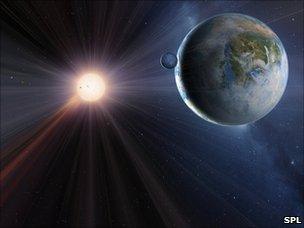Alien oceans could be detected by telescopes
- Published

The reflection of light or "glint" could reveal the existence of Earth-like planets.
The next generation of telescopes could reveal the presence of oceans on planets outside our Solar System.
Detecting water on Earth-like planets offers the tantalising prospect they could sustain life.
Scientists hope the reflection of light, or "glint", from mirror-like ocean surfaces could be picked up by a US space telescope set for launch in 2014.
The research by US astronomers has been published in Astrophysical Journal Letters.
Tyler Robinson at the University of Washington in Seattle is hoping this new technique could be used in the quest to find the Holy Grail for exoplanet astronomers - a possible sister to planet Earth.
"We're focussing on a class of extra-solar planets yet to be detected, so things comparable in size and composition to the Earth and similar distances from their central star as the Earth is from the Sun," he told 大象传媒 News.
The goal is to find something Earth-like in almost every sense of the world so we can even prove it has liquid oceans on its surface."
This kind of ocean could be the signature of a planet where life had developed in the same way as it did on our own planet.
Tyler Robinson hopes "glint" - the effect seen when light is reflected from an ocean's surface - may reveal the presence of Earth-like planets beyond our cosmic neighbourhood.
Beautiful sunsets
"The glint I'm talking about is pretty much the exact same thing when you talk about gorgeous sunsets over the ocean. With the sun low on horizon, sun beams come in and glance off the ocean surface which is acting like a mirror and you get these beautiful red sunsets."
This glint is more visible when a planet is in what's called a "crescent phase", similar to a crescent moon.
Glint detected on Saturn's moon Titan confirmed the presence of a methane ocean
At the moment, clues like these tell-tale glint spots are vital to finding Earth-like planets because, at distances of 20 or 30 light-years away, astronomers are decades from being able to image the surface of these alien worlds.
"You would need to have a telescope that is absolutely humongous to make these kinds of measurements. It would have to be on the scale of the distance between Earth and Mars," Mr Robinson told 大象传媒 News
Scientists have already used the technique to confirm the presence of a liquid methane ocean on Titan, Saturn's largest moon.
Tyler Robinson hopes the JWST could be used to help observe glint from exoplanets when it is launched in 2014. The JWST has been dubbed by some as the successor to Hubble and its job will be to peer into the early Universe and look for the formation of the first galaxies.
Oceans on Earth-like planets could have been favourable to the evolution of life
But the telescope would need a bit of extra help, he told 大象传媒 News.
"That on its own isn't quite capable of making these measurements. What we would need is an external occulter," Mr Robinson explained.
"This is a separate shield that you would launch into space that has the job of blocking the light from a star and by blocking that light it enables you to see the dim little planets that are orbiting around that star. "
As well as liquid water, another way life could be detected on exoplanets is through the presence of vegetation.
Chlorophyll, the green pigment in plant leaves, is very strongly reflective at near infrared wavelengths. This bright red appearance of vegetation at such wavelengths is known as the "red edge".
This has been suggested by some scientists as a way of detecting possible plant life on planets outside our Solar System.
- Published24 August 2010